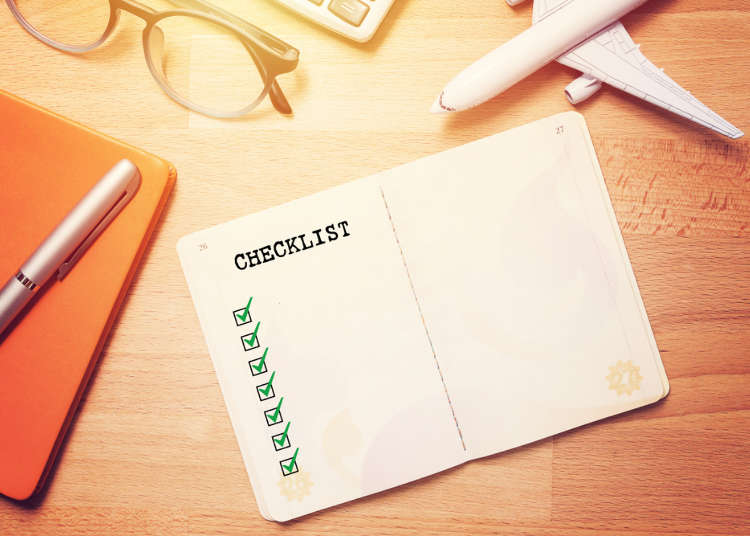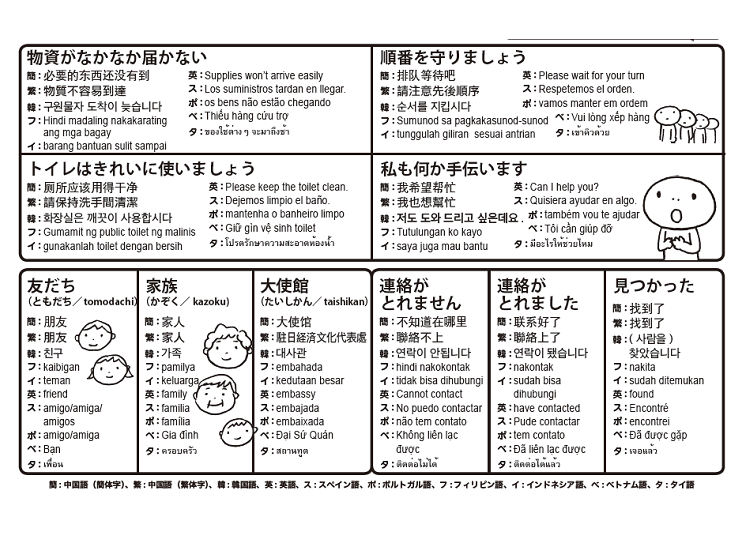
Japan is said to be one of the countries with the most natural disasters in the world. So, if you're heading to Japan, one of the most important things to do before your trip is to be prepared, and to know what could come your way.
There are a few things you should always have on you in case of an emergency, and one of those is a set of communication cards. These are simple, useful, easy-to-understand information cards that can be used in almost any country. Carrying these communication cards with you can be extremely helpful in emergency situations where you may not be able to use your smartphone.
Here, we'll show you everything you need to know about communication cards, and how to make your own.
1. What Exactly Are ‘Communication Cards?’

Nowadays, even a first-time visitor to Japan can easily find their way to small, local spots with the help of a smartphone. Even those who cannot understand or speak Japanese can get around with ease (for the most part!). Getting lost is almost a thing of the past - it seems that all you need is a smartphone to travel wherever you want.
But what do you do when you can no longer use your phone? Like in a natural disaster, for example? Most people have heard about the Great East Japan Earthquake of 2011, however many travelers still have little knowledge and experience on what to do when disaster strikes. This unfortunately often leads to a higher risk of falling victim to disaster, or having difficulty evacuating on your own in an emergency situation.
In many cases, smartphones may become unusable, due to power outages or radio interference. If you cannot speak Japanese, it can be difficult to obtain any information at all, which can also lead to pretty overwhelming situations. And while Japanese speakers are more likely to have their hands full helping themselves and attending to other Japanese speakers, it can be harder still to find other foreign language speakers who are free and able to help you.
This is where having a set of communication cards can really come in handy. They allow you to communicate your feelings and needs to the other party, even if you do not understand each other’s language. In an emergency situation, the most useful communication is that which is easy to understand. This is where communication cards play a very critical role.
Because of this, it is highly recommended to make a set of communication cards of your own first and foremost, before planning a trip to Japan, or indeed, anywhere else.
2. Keep Communication Cards Immediately Accessible

First, you should organize and establish the most important information and questions that are specific to you in case of emergency. For example, questions such as “Is this area safe?” “Where is the refuge area?” “Where is the hospital?” etc. If you find it a bit of a bother to carry multiple cards around, try writing these questions down on a single sheet of paper instead.
Start by writing the questions in English or your own native language. If you can understand some Japanese, you can write it in romaji, too. You could even draw simple illustrations where helpful.
The Japan Tourism Agency website, Safety Tips For Travelers, is geared towards foreign tourists visiting Japan and offers plenty of useful and necessary information for emergency situations, including communication cards that you can download.
In addition, you can find these communication cards available through the Safety Tips information app for tourists, also provided by the Japan Tourism Agency. They are available in five different languages (English, Traditional Chinese, Simplified Chinese, Korean, and Japanese). It is highly recommended to download them in advance, before your trip.
<Communication Card Example>

http://www.mlit.go.jp/common/001058529.pdf
3. Protecting Your Communication Cards From Water and Mud

Even if you make communication cards, they will be of no use if left behind in your luggage or at your hotel room! These cards should be kept on you at all times.
For example, what if a disaster were to occur while you are out visiting a tourist spot? Keep in mind that emergencies can happen at any time, even while you are out and about, therefore you should always carry communication cards with you, as well as other important items such as your passport and smartphone.
Also, if they are communication cards that you have made yourself, you want to make sure you keep them in good condition so they can be used for a long time. Remember, these cards are not only useful in Japan, but in any country you happen to visit.
First, securely paste the communication cards on a thick cardboard backing. Then, place each one in a laminated pouch (or coat the papers in a transparent laminating film that can be fastened with heat). In this way, you can ensure the communication cards will be protected from scratches and dirt, be made more durable, and will be easier to use.
The reason you want to take extra precautions to keep your cards strong and securely stored is because in an actual emergency, especially one occurring outdoors, it is possible to be exposed to conditions such as rain, snow, dirt, or mud. If your communication cards are damaged, they may become unusable in the most critical time. Because it is impossible to know if and when a disaster may strike, it is best to prepare these cards to be usable for many times, and for a long time. Once created, you can continue to use them, even on trips to other countries.
It may sound tedious, but you'll be thanking us in the long run!
4. Recommended: Creating an Additional "Point and Speak" Conversation Chart

With the number of tourists in Japan exceeding 30 million in 2018, it is important that as many as possible are made aware of Japan's natural disasters. But how many of them can communicate effectively in Japanese? For these visitors who may not be comfortable with the language, a "point and speak" conversation chart is highly recommended in addition to a set of communication cards.
Many countries have made "point and speak" charts available for overseas travelers, and have disaster-specific versions of them. Using these charts, it is easy for travelers to communicate their needs even if they cannot understand or speak the language, simply by pointing a finger. The charts are condensed versions of situation-specific expressions with icons and pictograms. You can also add your own additional symbols, numbers, words, and more as needed in order to communicate more accurately and effectively.
This chart basically plays the same role as the communication cards, but are more simple in that communication can be achieved by pointing to the appropriate image. Both are important tools to have in the event of a natural disaster, so please be sure to create and carry them with you at all times when traveling.
Here is an example of a point and speak conversation chart created during the Great East Japan Earthquake of 2011:
https://www.yubisashi.com/wp-content/uploads/yubisashi_shientool.pdf
The Joho Center Publishing Co., Ltd Office is available for free and in 10 different languages. Their purpose is to spread this information to as many people as possible, so you can copy and print it freely.
There are so many words and phrases here in different languages. We highly recommend searching various other useful icons and images in advance and printing them out as necessary.

Point and Speak Cards 2019.indd
If you print out this kind of helpful sheet, you'll be prepared for any kind of situation, regardless of whether your phone is working or not. Or you could even make one yourself, using colors and images that you think would get your point across. It's an interesting way to learn a bit of Japanese too! Take it one step further and make some for every day situations, so you never get caught out.
With communication cards, you'll feel that bit safer knowing you can. There are a few other ways you can prepare yourself too, so make sure to check out the links below to feel truly at ease before your trip!
*Prices and options mentioned are subject to change.
*Unless stated otherwise, all prices include tax.
Popular Tours & Activitiess
Recommended places for you
-
Goods

Yoshida Gennojo-Roho Kyoto Buddhist Altars
Gift Shops
Nijo Castle, Kyoto Imperial Palace
-
Appealing

Rukku and Uohei
Izakaya
Sapporo / Chitose
-

Jukuseiniku-to Namamottsuarera Nikubaru Italian Nikutaria Sannomiya
Izakaya
Kobe, Sannomiya, Kitano
-

ISHIDAYA Hanare
Yakiniku
Kobe, Sannomiya, Kitano
-

Kambei Sannomiyahonten
Yakiniku
Kobe, Sannomiya, Kitano
-

Kanzenkoshitsuyakinikutabehodai Gyugyu Paradise Sannomiya
Yakiniku
Kobe, Sannomiya, Kitano
-

Simply Oishii Wagashi School Discover Japanese Culture Through Wagashi: A Hands-On Experience!
by: Guest Contributor
-

How to Get Don Quijote's Exclusive 2025-2026 Winter Gift (+Tax-Free Savings)
-

The Best Japanese Food Representing 2025! 'Dish of the Year®' Annual Award Results Announced
-

[Extended Offer!](12% OFF KKday Coupon) Mt. Fuji Autumn Leaves, Powder Snow & More! 15 Best Tours to Experience Japan in Fall & Winter
-
Ad

Preserving the Beauty of World Heritage Site Shirakawa-go for the Future Through Responsible Travel
-

Keisei × Keikyu 16-Temple Goshuin Tour: Discover Deeper Tokyo & Yokohama
by: Guest Contributor
-

Most Beautiful Prefectures in Japan: Japanese People Rank Their Favorite Travel Spots Inside Japan!
-

Summer 2023 Buzz: Top 3 Trendy Collaboration Sweets Exclusive to Kansai
by: Shiro Tsuchida
-

Osaka Travel Service Center: So Many Incredibly Convenient Services - in English!
by: WESTPLAN
-

Why Hokkaido’s Hairy Crabs Are So Popular: Firm Meat Most Delicious in Spring!
-

Shibuya Crossing: Getting the Best View from the Deck at Magnet by Shibuya109!
-

Spending Wonderful Time Alone in Shibuya - Free Cosmetics and a Hundred-Yen Bus!
- #best sushi japan
- #what to do in odaiba
- #what to bring to japan
- #new years in tokyo
- #best ramen japan
- #what to buy in ameyoko
- #japanese nail trends
- #things to do japan
- #onsen tattoo friendly tokyo
- #daiso
- #best coffee japan
- #best japanese soft drinks
- #best yakiniku japan
- #japanese fashion culture
- #japanese convenience store snacks












